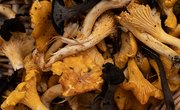
Hunting for edible mushrooms in Wisconsin is a popular pastime among locals. There are many species of mushrooms - which are the fruiting bodies of fungi - in Wisconsin. When starting, you must learn about edible mushrooms and their lookalikes from an expert mycologist (a person who studies mushrooms) to avoid poisonous varieties.
Warnings
Do not forage for mushrooms until you've learned how to distinguish between edible and poisonous mushrooms. An expert mycologist is the best person to talk to about mushroom identification.
Wisconsin Mushroom Hunting Ethics
It is legal to forage for mushrooms in Wisconsin state parks for personal use. When gathering mushrooms, or any food, from wild sources, you're permitted to collect only as much as you'll eat, to help protect natural resources. The rules for what can be foraged and how much vary between different parks, so mushroom hunters must check the specific requirements before collecting.
The mushroom is the fruiting body that the fungus uses to spread its spores, which grow new fungi. When picking edible mushrooms, use two fingers at the base of the stalk and snap it off. This technique helps avoid damaging the underground hyphae, or body, of the fungus. It is also advisable not to pick young mushrooms as they have not yet released their spores.
Morels in Wisconsin
Morels (Morchella spp.) are the most popular edible wild mushrooms in Wisconsin. Morel caps are cone-shaped with deep ridges that look like a honeycomb attached to a thick, white stalk. A true morel will be hollow when cut in half. The common morel (Morchella esculenta) appears in spring around May, while the black morel (Morchella augusticeps) is darker, smaller and starts appearing earlier in the season.
Morels grow mostly in the leaf litter around elm trees (Ulmus spp.). They can also be found around white ash (Fraxinus americana), white walnut trees (Juglans cinerea), among old non-commercial apple (Malus domestica) orchards or dying or dead hickory trees (Carya spp.). Those who don't find any while hunting in the woods can purchase morels at local markets for anywhere between $25 and $80 per pound.
The beloved morel mushroom hunting season only lasts four or five weeks in Wisconsin. Depending on the region, the season runs anywhere between early March and late May. The ideal climate for morels are days with temperatures between 60 and 70 degrees Fahrenheit and nights between 40 and 50 degrees Fahrenheit. Morels grow best in weather with a mixture of rain and sun.
Pheasant Back Mushrooms in Wisconsin
Pheasant back mushrooms, also called dryad's saddle (Polyporus squamous), are also popular in Wisconsin. In some areas, these mushrooms are more abundant than morels. Like morels, pheasant back mushrooms are commonly found around dead elm trees.
Their large, pale-brown mushroom caps are easy to spot as they stick out like shelves on the side of the base of dead trees and grow up to two feet wide. However, only the small mushrooms up to a few inches in size are tasty when cooked; old, large pheasant back mushrooms have a rubbery texture and are not pleasant to eat.
Poisonous Mushrooms in Wisconsin
All mushrooms in the genus Amanita should be avoided as they are deadly poisonous to humans. Many of the species in this group have a pure-white body, which can be confused with some edible mushrooms. Deadly skullcap (Galerina marginata) also grows in Wisconsin and shares toxic compounds with Amanita mushrooms.
Other mushrooms are edible, but only for some people. For example, sulfur shelf (Laetiporus sulphureus) is technically edible, but many people are allergic to them. Caution is necessary if you decide to try it.
Mushroom foragers should also be wary of any chemicals like weed killers used in the area, especially when picking mushrooms that grow among the grass like the edible fairy ring mushrooms (Marasmius oreades). Other mushroom fairy rings growing in the grass are deadly to eat: The large white-bodied false parasol (Chlorophyllum molybdites) may look harmless, but eating them is the leading cause of mushroom poisoning in North America.
References
- Wisconsin Public Radio: Nature's Treats: How to Find Morel Mushrooms and Other Wild Edibles
- Wisconsin Mycological Society: Thirty Edible Mushrooms
- Outdoor News: In Wisconsin This Time of Year, It’s All About the Morel Mushrooms
- Wisconsin Department of Natural Resources: Find Your Food
- University of Wisconsin-La Crosse: Polyporus Squamosus, Dryad's Saddle
- Wisconsin Mycological Society: Ten Poisonous Mushrooms
- North Carolina State Extension: Chlorophyllum Molybdites (False Parasol)
About the Author
Adrianne Elizabeth is a freelance writer and editor. She has a Bachelor of Science in Ecology and Biodiversity, and Marine Biology from Victoria University of Wellington in New Zealand. Driven by her love and fascination with all animals behavior and care, she also gained a Certificate in Captive Wild Animal Management from UNITEC in Auckland, New Zealand, with work experience at Wellington Zoo. Before becoming a freelance writer, Adrianne worked for many years as a Marine Aquaculture Research Technician with Plant & Food Research in New Zealand. Now Adrianne's freelance writing career focuses on helping people achieve happier, healthier lives by using scientifically proven health and wellness techniques. Adrianne is also focused on helping people better understand ecosystem functions, their importance, and how we can each help to look after them.
Photo Credits
Brandon Laufenberg/iStock/Getty Images
